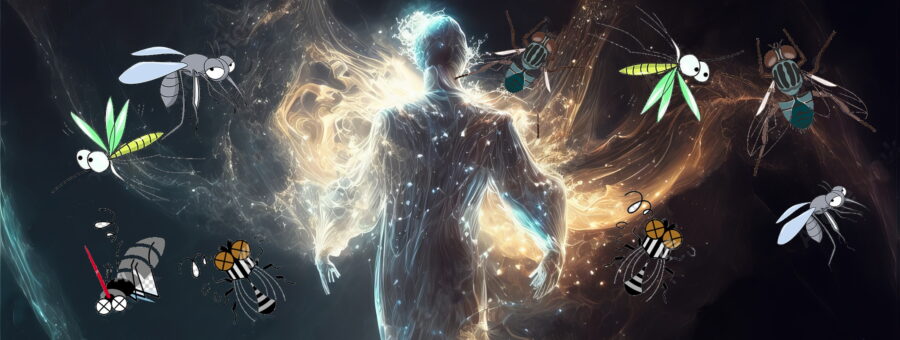Ward Off Pesky Flies with the Invincible Fly Shield

Shôn Ellerton, Apr 1, 2024
Finally, the solution to dealing with pesky flies and mosquitoes!
Well folks, I think we’ve finally stumbled across a solution to enjoying nature without being harassed by pesky flies and mosquitoes.
Let me impart this most exciting news to you.
The other night, I had dinner at the Adelaide Club, one of Adelaide city’s most exclusive establishments. The diners comprised of people from all walks of life including lawyers, bankers, politicians, scientists, war heroes, policemen, musicians, and even humble IT specialists like myself. But the most interesting conversation I had was with a Dr. Johann Rontelle, a not very well-known physicist with a background of entomology, the study of insects and other creepy crawlies.
Dr. Johann Rontelle, a wiry and short guy in his mid-sixties, recounted some of his adventuring days in the Swiss Alps before migrating to Australia. Like me, we both love Australia, but miss proper mountain climbing, the difference being, that I came from Colorado and Johann, from Switzerland.
Johann came over with his wife, Heidi, and two rather burley boys. Being seasoned campers, they have made the most of exploring the wilderness of South Australia and many other parts of Australia in general. We both agreed that this enjoyable pastime is seriously hampered by one of Australia’s most significant detractions regarding the great outdoors.
Flies!
Anyone living in or having visited Australia will know full well about the highly irritating and pesky bush fly. Unlike most conventional flies, these little creatures will fly up your nose, into your eyelids, your nose, your ears, or any other anatomical orifice to hand. Exceptionally persistent, they will stick to anyone like glue. Many will be familiar with the so-called Australian salute which is that act of constantly waving your hands in front of your face to stop flies landing on it.
The one redeeming feature of the Australian bushfly is that they don’t bite, unlike, for example, the notorious midges of Scotland and the nasty biting sandflies of New Zealand.
Johann’s specialty in physics is electric field theory, but what makes his work particularly interesting is that he has managed to couple his fieldwork with his passion for studying energy gradients that emanate from the human body. Being esoteric in nature, such knowledge has been dismissed as mere quackery by those within the mainstream of both the physics and medical establishments, however, neither establishment has ever claimed to have disproved such phenomena.
Johann and I got engaged in an interesting discussion on the use of fly repellents, insect meshes for hats, and dangling corks. Fly repellents, being atrociously smelly and bitter, are just horrible in general, especially when some of it mixes with sweat and gets in the eyes. Insect meshes, although effective in terms of flies trying to attach to one’s face, are a hindrance especially when flies start crawling over the net, or when one needs to have a drink or take a photo. And corks? Never ever seen anyone use them except for old British beer TV ads promoting Australian beer.
Johann spent a lot of his time in coming up with an ingenious solution which capitalises on his knowledge of electric field theory, human internal energies, and modern technology. His prototype uses a small portable ‘black box’ of sorts which attaches neatly to a trouser belt which is operated by a smartphone app, available to download once the product has been released in earnest. The so-called ‘black box’ is really about half the size of most smart phones but this is where the magic resides. Although it is battery operated, it also manages to transfer additional energy from both meridian lines in the body and magnetic flux energy lines from the Earth. Essentially, what is happening, is that this remarkable little device derives power from tapping into the congruence of physical battery, human energy, and Earth magnetic energy.
I asked Johann what this little device does and how it is related to the problem of being assaulted by the Australian bush fly.
I was surprised to learn that the device throws out an invisible energy shield which repels flies and mosquitoes from a distance of up to half a metre from every direction. He showed me a video featuring him with the device switched on as he walked through a thick field of midges. Sure enough, wherever he walked, the midges thickened up a little at the boundary of the invisible shield as they were being pushed away from him. This was nothing short of extraordinary.
But what was to come was even more surprising.
This little device had three modes of operation, with more to come as I understand it. All modes of operation are controlled by using the free app download for smart phone use.
The default mode, named the Repel Mode, was the mode of operation I saw on the video. Using less energy than the other two, and being more environmentally friendly and less disruptive, Johann expects this to be the normal modus operandi of the device.
The remaining two modes were created by Johann as an extra source of entertainment. However, Johann expects that these two modes could be outlawed by some authorities as being somewhat ecologically disrupting, as I will explain.
The second mode, aptly called the Drop Dead mode, uses more energy than the first, but instead of simply repelling the insects, as soon as they come into contact with the shield, they simply drop dead. Johann’s acute dislike of flies and mosquitoes manifested this devastating little creation, providing him with a feeling of sadistic enjoyment as they fall out of air leaving a trail of insect carcasses.
Even Johann appreciates the potential problem if everyone started to use the Drop Dead mode. The effect of so many fallen flies and mosquitoes would be such that the sea of dead insect bodies on the ground could herald unmitigated and unwanted ecological changes, much like what we did with introducing the rabbit to Australia.
The final mode, known as the Zap mode, really says it all.
When an insect hits the invisible shield, the insect is literally zapped by the energy field, releasing a loud pop and a little spark, much like those insect zappers you can buy today. Johann, of course, took the most pleasure using this mode, especially at night with a thick cloud of gnats or mosquitoes. He relates the experience to that of being surrounded by an electric field of fireworks but even more visually stunning is watching someone else with Zap mode turned on being enveloped in this kind of surreal blue sparkling popping envelope.
Again, as in the second mode, the ecological aftermath may be undesirable, but what is undeniably true with the third mode, is that it is great fun to use, although a little smelly caused by the smoke produced by the electrocution of the insects.
I asked the question, if the device was safe to use. Surely, the presence of an electric field surrounding one’s person may be problematic. What about a couple walking together? What about being in high humidity or in water? What about other flying objects?
I was assured that the device only works for insects within a specific mass range. For example, heavier insects including bees, dragonflies, moths and butterflies are not affected. Also, Johann explains that the technology embedded in this device is advanced enough to detect the type of insect it is trying to eliminate through the use of morphology recognition, an art which he is in the process of patenting. The device can be finally calibrated according to the shape, mass, speed, and colour of the insect.
As for water, the device can work in quite high humidity conditions, but it is not functional underwater, although the black box itself is IP rated for underwater use. And, with interaction of those organisms which do not fit the profile calibrated by the device, they are ignored. In other words, a couple could, even with each of their devices switched on to Zap mode, could walk hand-in-hand without any problem.
Finally, I asked when the device will be ready to market.
Johann’s answer was very simple.
‘Very soon, indeed. Perhaps even by April 1st, 2025!’


